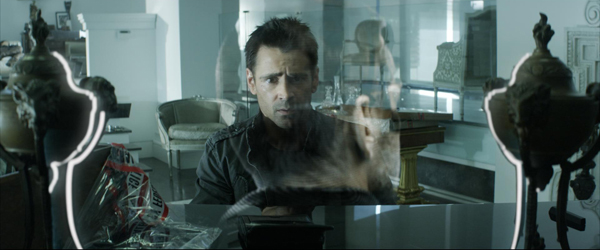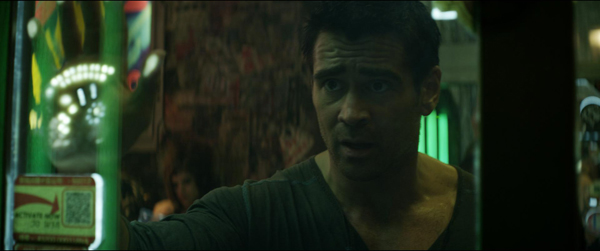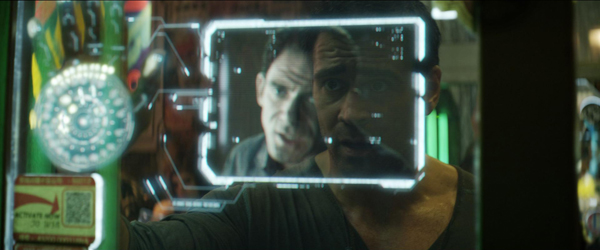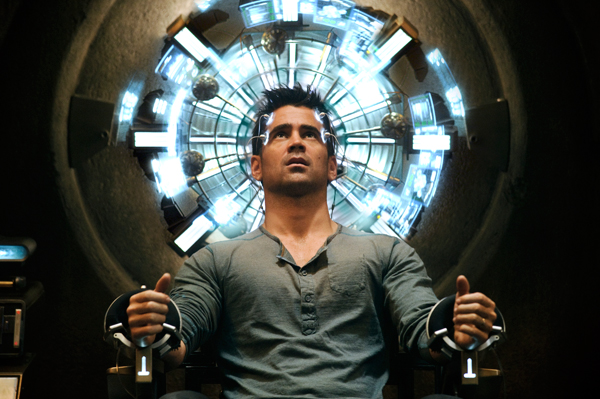
The Senate VFX and LipSync Post talk about their creative designs and FX behind the exciting 3D graphics and futuristic devices in ‘Total Recall’.
TOTAL RECALL - Tomorrow’s Memories |
|
The bold exciting cityscapes of ‘Total Recall’ are full of 3D graphics and futuristic devices, thanks to the creative design and FX skills at The Senate and LipSync Post. Among the most complex and subtle 3D graphics in the film was a hologram developed, designed and created byThe Senate VFXin London. A critical part of the story unfolds as the main character Douglas Quaid stands looking at a 3-dimensional image of his own face and head, delivering a message to him from his previous life as Carl Hauser, a resistance agent fighting against the United Federation of Britain, the UFB. Carl Hauser had planned that Douglas, a factory worker in the UFB’s downtrodden Colony, should find and activate this holographic recorded message, telling him what he needs to do to save himself and support the resistance movement. Douglas activates the recording by playing a series of notes on a piano located in Carl’s apartment. It appears on top of the piano like a talking statue, and is partly interactive in that Carl had prepared answers for questions he anticipated Douglas would ask him. |
 |
 |
Double IdentityVFX supervisor at The Senate Richard Higham said, “Our brief was literally a challenge from director Len Wiseman to explore how this sequence could be realized. He asked the team to present alternatives for him to respond to, explaining that the image should not be too ‘clean’ but include a level of noise and disruption, look slightly de-saturated and diffused at the edges showing a fall-off effect. He wanted a mixture of transparency and opacity, preserving the eyes and mouth to make the face readable.” The sequence required two separate shoots of the actor Colin Farrell who plays Douglas Quaid and Carl Hauser. Douglas was shot in the apartment set, producing the live action component. Carl’s head was shot on green screen by a specially designed array of 18 Canon 5D cameras positioned in a circle around him, each capturing QuickTime files of his head at a slightly different angle. At the same time, the production’s main RED Epic camera, captured his performance head-on. Thus, throughout the sequence his green screen performance was captured simultaneously at multiple angles. “This meant that Len could shoot the live action any way he liked, and we would always have the view and information we needed to create a perfect 3D hologram on the piano as it spoke to Douglas,” Richard said, “It was then up to us to select the best QuickTime at any given moment to match the live action camera move.” Various factors influenced the choice. For Len, establishing eye contact between the live action and the green screen Colin Farrell was vital. Furthermore, the camera was often on the move around the flat or around Douglas. In this case, they had to work out how to transition from one camera’s footage to the next, and used a mixture of projection onto 3D geometry of the actor’s head, and 2D morphing between takes. |
 |
Camera to CameraRichard explained their approach. “We had to be fully aware of where the camera was at all times and where it was looking because we had to track the head movement, in whatever angle we chose, as a 3D object track. While projection was the ideal technique, it was successful only if we had exact world space coordinates for the head location in the 3D space of the shot. There isn’t much tolerance for discrepancies when projecting onto the geometry – you might find the ear doubling up, or the image becoming foreshortened. Consequently, 2D morphing was usually the safer option,” he said. “What the geometry was very good for was as a base when creating and locating the ‘video’ noise and scan lines that Len wanted over the face. We were able to project the scan lines with the correct contours – not simply as rows of flat 2D lines - using a spherical projection technique within 3D space onto the tracked head, producing a truly 3D hologram.” This hologram head was interesting for the team because the work fell somewhat outside The Senate’s usual specialty in environments and invisible effects. Not only did it need to represent a fictitious, futuristic technology, it was a main focus of attention. However, once they had nailed the look Len wanted, they had to address the integration task of making it appear to have been captured in the image, at the same moment in time as all of the other elements. They also had to make it look believable. For example, to explain the source of the hologram, they positioned two small urns on the piano with a strip of white light emanating from them and sending out particles to suggest the 3D projection. |
 |
Complex Composite
The compositing had to be carefully addressed as well, and involved two aspects. Once the green screen performance had been composited and keyed, the 3D team would take this image and track it using 3DEqualiser and PFTrack. 3DEqualiser generated the 3D cameras in the scene, and PFTrack was used for the head because it includes paint deformation tools. “You can paint deformation into areas of the geometry where you know that, for example, the jaw line is moving because Carl is speaking. Therefore the geometry using that deformation is able to stretch and shrink based on what the mouth is doing and maintain all muscle movement.” They did the compositing in Nuke. From the 3D tracks generated by the matchmover, FBX files were created to import into Nuke, projected back onto a card to maintain the camera movement. The 3D rendered out all the different passes as well – the video can lines, UV maps and so on – which were very useful for the compositors to have all together when putting the scene together. Douglas Quaid’s first real glimpse into his recent past is a video message that Carl Hauser has left for him on an electronic device similar to a laptop, hidden away in a bank vault that a stranger alerts him to. Fortunately, this effect was a lot simpler for the team to create. “We created the display, again comprising a graphic of the screen border plus the footage of Carl, in danger and distress, delivering his urgent message for Douglas. Like the audience, he is still uncertain of the story he is uncovering,” said Richard. |
  |
Mobile PhoneOnce Douglas Quaid becomes a fugitive within the Colony, he moves out into the chaotic streets of New Asia. A stranger named Hammond, identifying himself as a fellow resistance agent who had worked with Carl Hauser, unexpectedly contacts Douglas through a mobile phone device embedded in the palm of his hand. He receives the message by pressing his hand against a pane of glass, revealing a hologram of the phone monitor display showing the stranger’s face speaking to him. To create this, The Senate was handed not only the green screen footage of the actor speaking, but also a complex animated graphic of the phone’s monitor and dial device. It included complex finger components that ran from the image to each of Douglas’ fingers resting on the glass, interactively shifting and realigning whenever Douglas moved his hand. In order to properly control the animation, the team had to dissemble the graphic components. They also had to animate and illuminate the practical phone in his hand, concealing it until it actually rang. “I also wanted the holographic image to appear as if illuminated from within the glass, not just sitting on the surface,” Richard said. “We duplicated the image and offset it to produce a feeling of z-depth. I approach story effects like these holograms and screens by inventing the technology in my head in a plausible way. I decided that when you press the glass, existing particles within it are energized by the phone device, causing the illumination. |
 |
 |
|
“Once we had the look and animation under control we added glows and composited everything with the green screen component into the glass. We added video scan lines as we had on Colin’s head, except of course they could remain 2D elements.” New Asia StreetsBecause the street sets were brightly lit, the glass already had considerable reflections shining into Douglas’ face. They introduced their effect without disturbing the existing light but working within it, maintaining the reflections over the top of the phone display. “Our choice was based on brightness. Any parts of our graphic that were brighter than the photography could take priority over that, or if the reflections on the glass were brighter than the display, those would prevail. This made it look much more natural. “It also makes glass hard to track – neither a reflection nor an object seen through it in the background, are good tracking points. 3DEqualizer was the best tool for it because we were tracking anamorphic material which is always tricky, not only due to the level of distortion but also the pixel aspect ratio. Anamorphic has a 2:1 ratio, which 3DEqualizer can take into account.” |
  |
|
The main challenge was the translucency, especially when the camera was looking both through the glass and through the hologram at Douglas Quaid. It was important to maintain the integrity of the glass, the hologram and the actor’s performance. In any case, whatever was visible through the glass, on the other side, meant adjusting levels of transparency and opacity in the screen display. Sometimes actors were performing on the other side; sometimes the scene was a section of 2D matte painting, part of New Asia’s elaborate digital set. Double Negative, the facility responsible for creating the movie’s digital environments, including the New Asia streets, would supply The Senate VFX with matte paintings which the team took apart as necessary to suit the shots they were working on. If the camera moves caused too great a perspective shift, they might receive 3D renders instead. These required balancing the grade, levels and depth of field to ensure they worked with the live action but also within the context of the whole sequence. The main point was to make the backgrounds in their shots indistinguishable from those in any others. |
LipSync Post Peter Chiang, production VFX supervisor from Double Negative, approachedLipSync Postin October 2011 regarding their availability for several key sequences in ‘Total Recall’. LipSync’s effects were to focus on several complex holograms, screen content and futuristic devices. VFX Supervisor at LipSync, Sean H Farrow, said, “We jumped at the chance to work with Peter again on a feature, having worked with him on ‘Stardust’, ‘Green Zone’ and ‘United 93’. The first shots were turned over to us in January 2012 and we finished the last Blu-ray shot in July.” |
 |
Bolo Gun Coils“Peter and Director Len Wiseman were both very articulate and would pick up pens to sketch out what they were looking for. We met with regularly with Peter to talk through the more complex and creative briefs. He was great at getting to the core of what each shot needed to achieve, leaving us to work out the practical aspects as well as do a lot of our own design and development. We also attended detailed briefings and feedback sessions with Len Wiseman,” said Sean. Sean explained, “We had two different remits - to animate something with a range of physical properties, and the need to match some very unusual live-action photography to make the weapon believable. The animation was achieved in a traditional staged process to produce a sense of speed, exaggerated 3-dimensional motion, and enough power to tie someone up in a moment. Due to the extended physical space the coils had to travel through, a procedural system wouldn’t have been adequate.” |
 |
 |
|
Specialised Rigging For example, while it could swoop violently towards camera and then back round the character, the length of certain coils had to triple from one frame to the next, and snap back again. “Since the look had such a dramatic effect on the feel of the animation, we went back and reanimated certain coils at specific moments to add more attractive individual frames to the sequence. “Then we applied numerous complex, multi-layered motion blur lighting passes to the coils. Len was keen to see a metallic element for the coils. When surrounded by that much light, that meant we had to pull various compositing tricks to make the darker, shinier metallic touches visible through the massive motion blur and very bright lights,” Sean said. |
 |
Animating a ConnectionThe look of the coils needed to match the shots that followed, caught in camera, as well as the look just as they were moving much faster than any of the live-action plates. Also, production had used specially prepared flare lenses that gave the coils a photographic quality and motion blur. “We spent a lot of time testing methods to mirror the photography, combining three separate motion blur techniques, all overlaid and dialled frame-by-frame to achieve the final look. We used PFTrack, Maya, mental ray and Nuke in pretty much every CG shot. “Establishing the connection between the bolo gun and bolo coils meant visualising something that was not magnetic, or electric, or even very physical at all. They investigated 30 or so very different types of connection, from physical, electrical, magnetic and ethereal through to almost invisible, until they hit the right note with Len. The selling point connecting the actual gun and the wrapped live-action coils lay between animation and perception. “No single frame would sell the effect, but on the run it felt like the characters were being pulled and physically manipulated,” said Sean. “This also meant that each shot had to be animated in a different way due to the duration, framing, lighting and movement of the camera, as well as whether the connection effect was coming on, already on, pulling, pushing and switching back off again. The subtlety of the effects combined with the extreme lighting in the scenes called for contrasting approaches to interactive light, from full body-track CG re-lighting to almost no interaction at all. The brightness of the coils often blew out subtle interaction.” |
|
|
Tripping DenLipSync worked on the Tripping Den sequences that unfold after Colin Farrell tries to temporarily escape the disappointment and drudgery of his life and visits Rekal Incorporated, a company that promises to implant exciting memories into their customers’ minds. The shots they were awarded required designing and building quite a few different CG elements. Specifically, they created a military ShrapCam missile, launched by soldiers invading the Tripping Den, that imbeds itself into a cement wall before ejecting hundreds of miniature cameras, both of which we designed based on practical models. The production had a physical missile inserted into a grenade launcher machine gun, held by the actor playing a soldier, to give us the starting parameters of the exterior look and scale. They designed the spikes, which extrude as the device is placed into the gun, and developed the expulsion mechanism after it sticks into the wall and spits out hundreds of the tiny ShrapCams. “We pretty much went straight to animation, since so much of the physical design was dependent on how it dispensed the cameras. We only had a tracking marker for the wall shots and used HDR images and the main unit’s action footage to create lighting maps,” Sean said. “Responding to feedback from Peter and Len, we took a shortlist of our designs into greyscale animated versions. These would be further refined into a shot and materials explored in more detail as we tweaked the animation. For detailed feedback, we adopted a staged process - concept, design, texture, model build and animation - and refined it as we progressed.” |
 |
Interactive ProjectionThe various recordings and image data from the cameras is relayed back to the soldiers’ backpacks for processing into an interactive holographic display, or projection, of the room they land in, using a mixture of 2D and 3D processes to locate Douglas Quaid’s position in the room. This was one of several different holographic effects, which are a distinctive feature of the movie, that LipSync was assigned to create. They found that each type of needed its own approach. “Each set of holographic displays had to tell a specific story in a short space of time, while keeping the futuristic look and feel of the movie. These parameters, as well as collaborating with Len and Peter drove each look in a slightly different direction,” said Sean. The first was the POV view of one of the tiny ShrapCam cameras. “We designed the graphical content, combined it with live action film footage, and applied a ‘scanning’ and digital screen look to it to give the sense that you were inside the ShrapCam gathering information and surveying the room. Ultimately it was the information from these ShrapCams that was broadcast back to the soldier’s pack. |
 |
Practical FXInterestingly, the production had to essentially recreate the ShrapCam technique well enough to produce imagery that looked as though one of these missiles had been used to create it. The production had placed dozens of GoPro HD cameras in and around the Tripping Den set and shot everything on extremely wide lenses. The massive output from over a hundred of them was then treated and composited into the backpack’s holographic interface to show what the ShrapCams were seeing around the room. When the soldier activates the holographic function of the backpack, it builds a 3-dimensional sphere comprising all key angles taken from the room. Sean said, “The look and feel of this holograph did not rely on anything else in the film, giving us free reign to develop a look that was interesting, 3-dimensional, and showed what the soldiers see going on inside the Tripping Den. Upon command, the 3D sphere of images translates into a holographic projection of the room, in which Douglas Quaid can be seen moving around. “We built the room based on Lidar scans of the set, and took this into Nuke. We could animate the room, globe and even Douglas within Nuke allowing us to keep a consistency of look and ensure we could tweak very specific moments and areas of the shot to suit the feedback. This whole process meant we could turn around fully fleshed out 3-dimensional versions quickly without having to go through the 3D pipeline.” |
 |
Hydraulic InspirationAnother piece of military kit for this scene was a high-powered door ram. Inspired by hydraulic engineering, the door ram is a compact disc that, once activated, expands in three dimensions before punching through a metal door. Sean and the team found it was a lot of fun to develop. “We had a physical prop base of about an inch deep to start from and handed this over to our concept artist to sketch up ideas of how it looked when it was extended. We drew ideas from practical rams, drills and military gun muzzles, and then ‘future-ised’ them by combining them with more interesting devices and materials and changing the balance between making it look cool and robust.” The CG build and animation were important as this device needed to extend to about five times its depth and still look dangerous and solid enough to bust through a steel-cased door. The interior of the ram has a drilling mechanism inspired by the drill machine vehicle in the original ‘Total Recall’ with the spinning drill bits and blades. |
 |
Illuminated TattooLipSync created an illuminated tattoo seen on the back of the receptionist who greets Quaid at Rekal. The work involved a complex body track and the creative use of 2D lighting effects to effectively mimic the practical tattoos seen on other characters. |
 |
 |
Interactive SecurityThe team was especially excited about designing the look of the interactive security scanner graphics in the Fall’s departure terminal, a sequence that also involved quite a few head replacement and crowd replication shots. This sequence makes a reference to an immediately recognisable scene from the original ‘Total Recall’. The artists were supplied with a set of 2D motion graphics as a foundation template, which they took into Nuke and developed into a full 3D interactive holographic mini-environment with all of the alternative scans for each passenger. As Quaid passes through the scanner, his head and face shift and change from one identity to another. CG heads weren’t required because the production had taken care to shoot head elements in the same lighting conditions, but the principle of matching one person’s moving head onto another needed careful animation re-timing, paint work, scaling and hand-tracking. Beyond the scanner, a large number of other holographic visuals were required for these shots. LipSync designed and animated the guard’s interactive graphics to follow the action precisely from shot to shot, using similar look techniques developed for the main scanner and taking cues from the graphical design done earlier. Further to this were holo-arrows travelling along passenger barriers as well holographic advertising boards near the ceiling, plus ATM graphics, boarding info panels and animated glass holograms that Douglas Quaid eventually smashes though. |
|
|
Assassination CodeAS the climactic sequences in the film approach, more holographic imagery were needed in resistance leader Matthias’ hideout when he helps Quaid remember his past - in particular a code detailing an assassination plot. Because the visuals were conceived near the end of the post schedule, they not only designed the look of the holographic elements, but also created the graphics themselves. As these graphics were such key story point, they aimed to keep the story beats clear while still matching their look to the ‘Total Recall’ world. “We knew we had to get it close on the first pass. Otherwise we'd all be facing an even steeper challenge with the finish line approaching. We completed several processes in tandem. We designed the content graphics at the same time as designing the story reveal, developing a look for the holographs and prepping all of the shots for compositing. Normally we'd be waiting for graphics and then comp them in, but in this case, with so little time we needed to design and create everything in one timeline.” The presentation of the first pass to Len went well enough to progress further with the sequence, continuing to develop the graphics, animations and the look of the composited screens as they worked through the storytelling aspect - all completed in just under those four weeks. Words: Adriene Hurst |





















